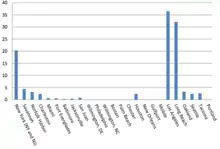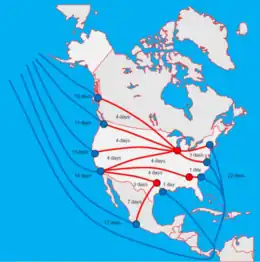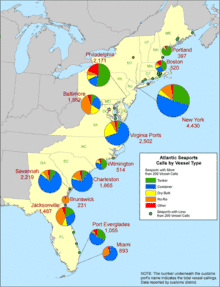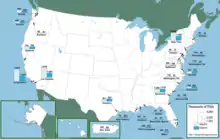

The United States has more than 20 container ports around its coastline.
West Coast
| Port | Draft depth | Air draft |
|---|---|---|
| Port of Seattle | 50 feet (15 m) | Unlimited |
| Port of Tacoma | Greater than 50 feet (15 m) | Unlimited |
| Port of Portland | 40 feet (12 m) | 196 feet (60 m) |
| Port of Oakland | 50 feet (15 m) | 190 feet (58 m) |
| Port of San Francisco | 50 feet (15 m) | 220 feet (67 m) |
| Port of Hueneme | 40 feet (12 m) | Unlimited |
| Port of Los Angeles | Greater than 52 feet (16 m) | Unlimited |
| Port of Long Beach | Greater than 50 feet (15 m) | Unlimited |
| Port of San Diego | Greater than 35 feet (11 m) | Unlimited |
Gulf of Mexico
| Port | Draft depth | Air draft |
|---|---|---|
| Port of Houston | 45 feet (14 m) | Unlimited |
| Port of New Orleans | 45 feet (14 m) | 170 feet (52 m) |
| Port of Gulfport | 39 feet (12 m) | Unlimited |
| Port of Mobile | 45 feet (14 m) | Unlimited |
| Port of Tampa | 43 feet (13 m) | Unlimited |
East Coast

| Port | Draft depth | Air draft |
|---|---|---|
| Port of Miami | 55 feet (17 m) | Unlimited |
| Port Everglades | 43 feet (13 m) | Unlimited |
| Port of Palm Beach | 36 feet (11 m) | Unlimited |
| Port of Jacksonville | 40 feet (12 m) | 175 feet (53 m) |
| Port of Savannah | 42 feet (13 m) | 185 feet (56 m) |
| Port of Charleston | 45 feet (14 m) | 186 feet (57 m) |
| Port of Wilmington (North Carolina) | 42 feet (13 m) | Unlimited |
| Port of Virginia: | ||
| *Norfolk International Terminals | 50 feet (15 m) | Unlimited |
| *Portsmouth Marine Terminal | 50 feet (15 m) | Unlimited |
| *Newport News Marine Terminal | 50 feet (15 m) | Unlimited |
| *Virginia International Gateway | 50 feet (15 m) | Unlimited |
| Port of Baltimore | 50 feet (15 m) | 185 feet (56 m) |
| Port of Wilmington (Delaware) | 38 feet (12 m) | 188 feet (57 m)[1] |
| Port of Chester | 45 feet (14 m) | 188 feet (57 m) |
| Port of Philadelphia | 45 feet (14 m) | 188 feet (57 m)[1] |
| Port of Camden | 45 feet (14 m) | 150 feet (46 m)[1] |
| Port of New York and New Jersey: | ||
| *Port Newark–Elizabeth Marine Terminal | 50 feet (15 m) | 215 feet (66 m) |
| *Port Jersey | 50 feet (15 m) | 228 feet (69 m) |
| *Howland Hook Marine Terminal | 50 feet (15 m) | 215 feet (66 m) |
| *Red Hook Container Terminal | 50 feet (15 m) | 228 feet (69 m) |
| Port of Boston | 47 feet (14 m) | Unlimited |
| Port of Portland (Maine) | 32 feet (9.8 m)[2] |
Dredging of east coast ports are under way[3] because of the New Panama Canal expansion and the expectation of larger container ships.
The Jasper Ocean Terminal is a planned container terminal to be built on the Savannah River downstream of Savannah, GA that is expected to begin operations in the mid 2020s.[4]
Global supply chain disruption
The supply chains that were disrupted during the COVID-19 pandemic faced huge challenges and struggled to recover. Industries around the world shutdown due to the rapid spread of the virus in 2020. There was reduced industrial activity and lower consumer demand. While consumer demand increased quickly when lockdowns were lifted, manufacturers and distributors of goods were stymied by worker shortages and a lack of key components and raw materials. Additional bottlenecks included containers, shipping, trucks, railroads and warehouses.[5] Ports around the world were impacted with ports in the United States in particular experiencing blockages as they were overwhelmed with container ships and their cargo.[6] The ports of Long Beach and Los Angeles together account for approximately 40% of the shipping containers entering the United States.[7] More than three-quarters of the containers leaving Los Angeles were empty in July 2021 whereas about two-thirds of the containers leaving U.S. ports are typically filled with exports. Many of containers were going back empty due to the rush by shippers to bring in imports of back-to-school supplies and fall fashions from Asia.[8] This impacted Midwestern farmers and California Almond Growers who ship to customers overseas.[9] Shipping companies placed a lower priority on products that paid lower shipping rates resulting in various exports being delayed.[8] In October, there were a record number of ships at the docks of these two Los Angeles area ports as well a record number of ships waiting for a slip.[10] In early November, more than 100 ships were anchored in San Pedro Bay.[11] It was unusual for even one vessel to be waiting offshore before the coronavirus pandemic.[7] In late 2021 and the first month of 2022, container ships have remained at American ports unloading goods for seven days on average, 21 percent higher than at the start of the pandemic. The mayhem at ports and shipping yards was a key driver for rising prices together with the market dominance of major companies. In early 2022, politicians and central bankers worked to tame inflation as businesses continued to struggle to manufacture and distribute their products.[12] By July the total value of trade stuck on the water off the east and west coast ports was estimated at roughly $30 billion. Another $1.5 billion in trade was waiting for rail service at the Ports of Long Beach and Los Angeles which was 60% of all containers waiting at these ports.[13] By September 2022, the backlog at U.S. ports decreased partially due to slowing U.S. import volumes amid high inflation and rising interest rates.[14]
See also

References
- 1 2 3 "Bridges and Cables" (PDF). Moran Shipping. Retrieved April 3, 2019.
- ↑ "Port of Portland, Maine, U.S.A." www.findaport.com. OneOcean Group Limited. Retrieved August 1, 2023.
- ↑ Brennan, Morgan (August 7, 2015). "Ports: What's bad for West Coast is good for East". CNBC.
- ↑ "Jasper Ocean Terminal plans on fast track". Business in Savannah. May 2, 2016. Retrieved January 23, 2017.
- ↑ Selyukh, Alina (November 15, 2021). "Warehouses are overwhelmed by America's shopping spree". NPR News. Retrieved November 16, 2021.
- ↑ Ellyatt, Holly (October 18, 2021). "Supply chain chaos is already hitting global growth. And it's about to get worse". CNBC. Retrieved November 8, 2021.
- 1 2 Wilkie, Christina (October 13, 2021). "White House plan aims to help key West Coast ports stay open 24/7 to ease supply chain bottlenecks". CNBC. Retrieved November 8, 2021.
- 1 2 Horsley, Scott (July 23, 2021). "Farmers Have A Big Problem On Their Hands: They Can't Find A Way To Ship Their Stuff". NPR News. Retrieved November 16, 2021.
- ↑ Sahagún, Louis (July 5, 2022). "A billion pounds of California almonds stranded at ports amid drought, trade woes". Los Angeles Times. Retrieved July 6, 2022.
- ↑ "As Many As Half A Million Shipping Containers Could Be Waiting Off Ports Of LA, Long Beach". CBS Los Angeles. October 4, 2021. Retrieved November 8, 2021.
- ↑ Burnett, John (November 5, 2021). "Waiting on that holiday gift from your online cart? It might be stuck at a seaport". NPR News. Retrieved November 8, 2021.
- ↑ Goodman, Peter S. (February 1, 2022). "A Normal Supply Chain? It's 'Unlikely' in 2022". The New York Times. ISSN 0362-4331. Retrieved February 2, 2022.
- ↑ LaRocco, Lori Ann (July 15, 2022). "Over $31 billion in trade is rail-landlocked or stuck at anchor off U.S. coasts". CNBC. Retrieved July 16, 2022.
- ↑ Ryssdal, Kai; Hollenhorst, Maria (September 29, 2022). "How's the container ship backlog at Southern California's ports?". Marketplace. Retrieved September 30, 2022.
Further reading
- U.S. Port and Inland Waterways Modernization: Preparing for Post-Panamax Vessel, U.S. Army Corps of Engineers, June 20, 2012
External links
![]() Media related to Container terminals in the United States at Wikimedia Commons
Media related to Container terminals in the United States at Wikimedia Commons



